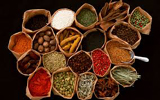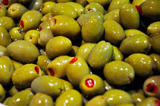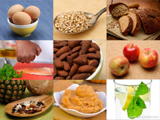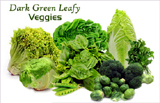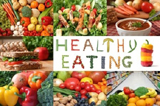Nutrition and diet
Eating for Health: a new system, not another diet — II
Eating for Health is a way of life. It reflects a relationship to food based on consciousness, gratitude, sound science, and positive energy. — Edward Bauman, M.Ed., Ph.D.
Abstract
Abstract In Eating for Health — I, the core principles of the system were introduced. Primary among this holistic approach are: 1) Bio-individuality; 2) Four levels of eating; and 3) Whole food synergy. In Part two, the following concepts and practices will be discussed: 1) Diet-disease connection, 2) Food health connection, 3) Eating for Health Food Groups, and 4) Diet Direction. The impact of nutrient depleted, chemically altered food, combined with stress and environmental toxicity is a growing threat to all species and the natural order. The Eating for Health diet, lifestyle and attitude aims to shift the mass food paradigm from convenience to conscious eating.
The Diet-disease connection
Statistics for 2014 indicate that heart disease causes almost one third of all U.S. deaths (1). More than 68 percent of American adults over the age of 20 are overweight or obese; 8.3 percent of our adult population has diagnosed type-2 diabetes, while about half that many are thought to be afflicted with it but undiagnosed; and another 38.2 percent of adults have pre-diabetes (2), an almost equally dangerous condition of high blood sugar.
Current research acknowledges that the standard American and global commercial food dietary pattern, with its emphasis on processed, packaged and fast foods full of damaged fats, refined flours and sugars and lack of nutrient density, leads to profound changes in metabolic functions. These changes eventually lead to inflammation, the key causative factor in obesity, blood sugar disorders including type-2 diabetes, cardiovascular disease and other chronic degenerative conditions (3,4,5,6,7). Damage from toxins, both from the food supply and the environment, creates an additive effect (8), as do stress and lack of physical activity.
During the sixty-year period from 1910 to 1970, the American food supply underwent profound changes, as it became decentralised and industrialised. The proportion of traditional animal fat in the American diet declined from 83 percent to 62 percent, and butter consumption plummeted from 18 pounds per person to four. During the same period, the percentage of dietary vegetable oils in the form of margarine, shortening, and refined oils increased by about 400 percent, while the consumption of sugar and processed foods increased by about 60 percent (9). Add to this, the huge increases seen since World War II in the use of chemicals that rid our foods of insects, fungus, and weeds and the recipe for a diet detrimental to health, starting in childhood or earlier, is complete.
For the first time in history, the next generation will not live longer than their parents. Diseases such as Type-II diabetes, high blood pressure, heart conditions and joint deterioration — what were once considered adult diseases — are regularly being diagnosed in children. What is particularly tragic is that studies have suggested that obesity in children today may contribute to a two-to five-year decline in their life expectancy, shorter than that of their parents, due to obesity-related diseases that are largely preventable (10).
Food and health connection
Traditional healing systems such as Āyurveda, Chinese medicine, Greco-Roman and naturopathic medicine echo the advice given by Hippocrates over 2,000 years ago to use food as medicine. More recently, research has made a strong case that nutrient-rich food is a primary promoter of health and protector from disease. Fresh whole food, grown on nutrient and micro-organism rich soil, supports life and health in a number of ways. It provides:
(1) digestible proteins to build and repair body tissue;
(2) nourishing fats that support nervous and endocrine function;
(3) colourful carbohydrates that provide fibre, vitamins, minerals, and phyto-nutrients that lower inflammation, favourably influence cell metabolism, genetic expression and detoxification.
In India, where spices are part and parcel of everyday cooking, a fascinating study reported that spices significantly stimulated pancreatic enzymatic production. Pancreatic amylase, lipase and disaccharidase enzymes (sucrase, lactase, and maltase) were enhanced by the addition of ginger and turmeric. Other spices tested that increased enzymatic production included coriander, ajowan, fennel, cumin, asafoedita, capsaicin and piperine (11). With a greater output of pancreatic enzymes, digestion and assimilation will be more efficient, yielding a greater uptake in the quantity and variety of nutrients to nourish, protect and heal body tissues, organs and stressed body systems.
A meta-analysis of 206 epidemiological studies found the ingestion of raw vegetables to have the most consistent and powerful association with the reduction of cancers of all types, including stomach, pancreas, colon, breast. (12). Lightly cooked, baked or sautéed vegetables would also be of value as long as they are not overcooked and the nutrients in any cooking stock are not discarded.
The prospective Physicians Health Study II tracked the dietary patterns of 21,454 male physicians for 17 years (13). The most dramatic relationship between survival and food intake was nut consumption. A comparison was made on the cardiovascular function of doctors who ate nuts and seeds two or more times per week as compared to no nuts or seeds. Those eating nuts and seeds showed favourable results. It was noted that nuts and seeds had anti-arrhythmic and anti-seizure effects, associated with 60 percent reduction in sudden cardiac death. Low fat (10 percent of calories from fat or less) diets with no nuts or seeds increased the risk of ventricular fibrillation or other life-threatening arrhythmias. Nuts and seeds, positioned at the centre of the Eating for Health model are an excellent plant source of protein, fatty acids, vitamins, minerals and phyto-nutrients. A meta-analysis of 23 interventional trials involving nut and seed consumption noted those eating 1 oz. per day, 2 or more times per week showed:
(i) a large drop in LDL cholesterol, especially the most dangerous small dense LDL;
(ii) a significant rise in the beneficial HDL;
(iii) a reduction in C-reactive protein and plaque adhesion molecules and
(iv) improved vascular elasticity (14).
The longest-living societies have the following behaviours in common. They (i) eat no processed foods, (ii) eat mostly vegetables/self-grown, (iii) are physically active throughout their lifespan, (iv) have warm social relationships outside of their primary family, and (v) don’t over-eat. In long-living societies, females averaged 1,200 calories per day as compared with the American average of 1,600 calories, while males averaged 1,900 calories per day as compared to the American average of 2,600 calories (15).
Beyond the hubbub of the ‘which diet is best food’ debate emerges one common denominator: the claims of superiority of one approach over another are heavily exaggerated because the “eating patterns associated with meaningful evidence of health benefit overlap substantially” (16). All that healthful dietary approaches have in common is precisely what the Eating for Health programme has proclaimed since its inception: that real, whole food, minimally processed, and with an emphasis on plant foods is life and health supportive and disease preventive (17). As Michael Pollan stated succinctly in his book, In Defense of Food: “Eat food. Not too much. Mostly plants (18)”.
Food fortification and dietary supplementation
The United States has been supervising the fortification of packaged foods for decades, in an effort to reduce nutrient deficiencies in susceptible populations. However, in addition to the problem of supplying just a few of the known nutrients, and in synthetic forms, scientists from the United States Department of Agriculture (USDA), and other top nutrition researchers, have acknowledged that in trying to remedy the nutritional deficits of a few, we run the risk of “over-fortification or under-fortification in the food supply and nutrient imbalances in the diets of individuals (19).” In fact, it is estimated that close to half of all American children aged eight and younger are consuming potentially harmful amounts of vitamin A, zinc, and niacin because of excessive food fortification (20). The message from this study can be construed as meaning that optimal nutrition results from a diversified diet of real foods, not from the addition of government-blessed nutrient supplements. The researchers urge consideration of all segments of the population and not simply those who may be at risk of deficiency and they question the enrichment of foods with nutrients that may or may not be part of a food’s natural nutritional profile. Perhaps most importantly, they note that while many vitamins are added to foods, minerals (other than iron and calcium) are not, which could lead to serious imbalances.
While the Eating for Health programme recognises that nutrient supplementation is commonly required for optimal health, blanket enrichment of the country’s processed food-supply can be a potentially health-impairing practice, and one that allows an attitude of complacency among individuals rather than one of taking responsibility for one’s health. This concern is warranted, as, “four out of five Americans purchase foods and beverages specifically because of fortification or another added benefit. About one-third believes that fortification has a moderate or great impact on their overall health. A little more than one-quarter indicated that fortified foods have a great or moderate impact on their food purchasing decisions (21)”.
The dietary supplement industry, too, has matured in the past few decades and is now showing signs of huge growth, as products are available online, at convenience stores, in grocery stores and through healthcare professionals. The issues associated with food fortification apply here, as well, and the health promises promulgated through advertising rarely deliver, as supplemental nutrients can’t take the place of a diverse whole foods diet. They can, however, fill in nutritional gaps, and they can, with professional guidance, be used therapeutically in the management of many health conditions.
Eating for Health food groups
Because Eating for Health is a system, not a diet — a set of organising principles around which to construct a nutritious eating style and a healthful lifestyle — its food groups are limited primarily by considerations of quality. Therefore, recommended protein foods include those from plants as well as from animals and their by-products. Animal foods are best when as organic as possible and raised on species-appropriate foods, free of growth hormones, antibiotics and additives. This includes grass and/or pasture for animal protein (including for laying hens); and for fish, it suggests they be sustainably caught in the wild, not farmed. For plant proteins, organic sources are also preferred. Proper preparation is highlighted as a means of deriving as much nutrition from them as possible. This includes soaking or sprouting beans before cooking them; soaking and dehydrating or lightly toasting nuts and seeds; and soaking, sprouting, or fermenting whole grains.
Recommended fats are primarily those found in whole foods, such as olives, avocados, nuts and seeds and organic animal sources. The addition of fats and oils separately is also fine, provided they are minimally processed and of the highest quality, especially for the polyunsaturated fats, whose structures render them very sensitive to heat and light. Fats of all types — saturated, monounsaturated and polyunsaturated — all have health benefits, providing they are consumed according to one’s needs at any given time, and with attention paid to existing health conditions. Organically grown is of extreme importance, due to genetic modification and heavy pesticide use in conventional varieties. Many of our environmental toxins accumulate in the fatty tissues of both food plants and animals, with increasing concentrations seen in animals at the higher levels of the food chain (22).
The same principles apply to carbohydrate foods, since choosing organic grains, fresh vegetables and fruits almost always ensures higher levels of nutrients and lower levels of contaminants than do conventional varieties (23,24). However, purchasing as locally as possible, organic or not, often provides very high levels of nutrients, due to freshness (25). Eating for Health carbohydrate foods include non-starchy vegetables, whole fruits and fresh fruit juices and unrefined starches: whole grains and root and tuber vegetables. Because the plant world provides the highest concentration of anti-inflammatory nutrients, consuming broths from vegetables and fresh juices or smoothies from both vegetables and fruits, on a regular basis, is a recommended way to obtain an abundance of this goodness. However, because of its reliance on scientific research as the guiding principle in its food recommendations, Eating for Health also places great emphasis on keeping the gut’s bacteria plentiful and balanced as a means of providing the conditions necessary for obtaining the most benefit from these plant compounds (26), which leads us to our next group.
Booster foods is a term coined by Dr. Bauman to describe nutrient-dense foods, condiments and food supplements that can give a strong nutritional boost to our everyday diets. Given the increased nutrition needs for those recovering from a standard American diet, experiencing ongoing stress or toxicity, or who are recovering from illness, this is a concept that we hope to see more of in the research literature as the field of nutrition science progresses. Adding booster foods to the diet is a better way to provide an energy boost to one’s day, without having to rely on stimulants, such as sugar and caffeine. Among the booster foods are lacto-fermented foods — vegetables, fruits, grains and dairy — that provide valuable beneficial bacteria to our gastrointestinal tracts. These powerful modulators of digestive and immune function help us extract vitamins and minerals from our foods and neutralise anti-nutrient factors, such as phytates and oxalates, which prevent us from obtaining a food’s full complement of nutrients (27). Booster foods also include herbs and spices, which are used as condiments or in teas. Gram for gram, they contain greater amounts of nourishing and anti-inflammatory phytonutrients than any other food source, though algae, such as spirulina, chlorella and sea vegetables come very close. These three are highly recommended — spirulina and chlorella in powder or pill form and sea vegetables as tasty additions to broths, salads and grain dishes. Other booster foods include nutritional yeast, bee pollen, fermented foods, condiments such as miso and vinegar, and a small (one ounce serving) piece of dark (70%) chocolate or cocoa powder.
Booster foods generally provide the very nutrients often missing in action in the American food-supply, healing micro- and phytonutrients. When these are added on a daily basis, one’s need for dietary supplements will decrease. Booster foods can easily and deliciously be incorporated into the diets of even very picky eaters, as long as they are not overpowering. As one widens his or her food choices, one’s palate can also change to appreciate new flavours that are bitter, pungent, savoury and astringent.
The last Eating for Health food category — beverages — is one that is sometimes forgotten in the current diet book jostling for macronutrient supremacy. Yet with bodies that are approximately 80% water, beverages play a vital role in our health and vitality. The number one beverage is clean water, which often means filtered or from glass bottles. Water in plastic bottles is discouraged, due to the possible leaching of chemicals. But beverages also include black, green and herbal teas; organic coffee (1/2 c. day), broths, fresh diluted vegetable and fruit juices and unpasteurised fermented drinks, such as kombucha and kvass.
Diet Direction
One can use the Eating for Health model (shown below) as a way to establish a Diet Direction in a simple and practical way. If one aspires to following a Cleansing Diet, it is advised to emphasise foods from the outer rings of the model in abundance. This would mean increasing the quantity and quality of beverages to include purified water, fresh, diluted juices, mineral broths, and a variety of organic teas. The next category to use as the basis of one’s food plan would be colourful carbohydrates as represented by fresh seasonal fruits, leafy vegetables, crunchy vegetables and unrefined (gluten-free) grains and starchy vegetables. These health supportive beverages and plant foods could be further enhanced by the addition of booster foods, consisting of herbs and spices, algae and seaweed, nutritional yeast, and condiments such as raw apple cider vinegar and miso. High quality protein and fats would also be included in a cleansing diet, but in smaller proportions on the plate and in caloric proportion to the abundance of colourful, high fibre, unrefined carbohydrates.
The reverse would be true for a Building Diet. For this direction, one would build a meal from the inside-out, starting with high quality fats and protein, plentiful booster foods, fewer servings of unrefined starches and fruits, but unlimited amounts of leafy and crunchy vegetables. Beverages remain the same, though emphasis would be placed on vegetable rather than fruit juices.
A Balancing Diet Direction provides a broad range of choices, providing macronutrient ratios in-between Cleansing and Building, but maintaining unlimited amounts of leafy and crunchy vegetables, which form the firm foundation of Eating for Health food choices.
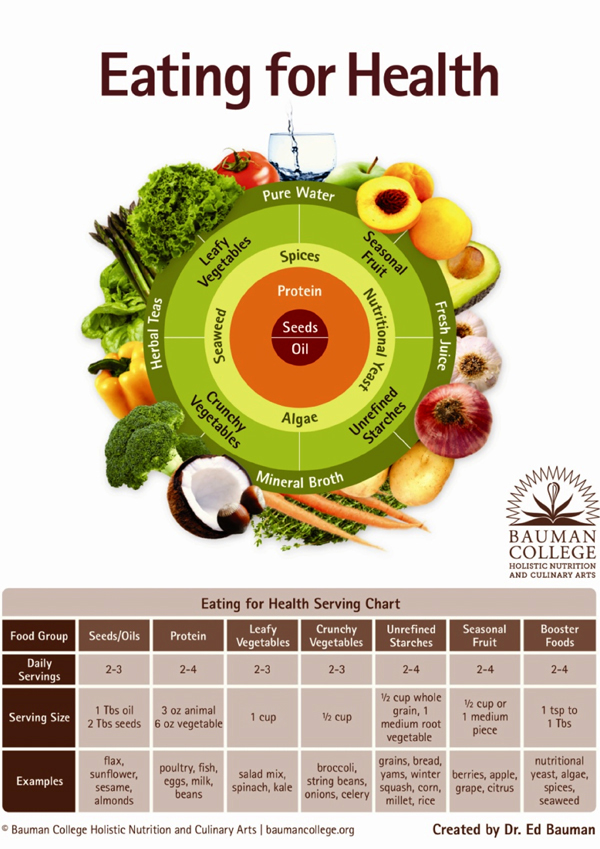
Commitment to change
Change is the one constant in our lives. Let’s investigate how to change for the better and improve our health by supporting our metabolisms, brain function and abilities to self-heal. Cleaning up the diet by clearing out the debris in our pantries, refrigerators and medicine cabinets is a good start. Finding out how to shop for, prepare and enjoy healthful foods is the key that unlocks the door to renewed health and vitality. A step towards guiding a person to formulate a personalised cleansing, building or balancing diet of wellness is to meet with a holistic nutrition professional to receive an in-depth assessment and analysis of one’s current eating habits, choices and health issues. A nutrition professional can review and evaluate your diet, inform you about the latest scientific research and advise on specific amounts and combinations of therapeutic foods, herbs and nutrients to promote healing and help a person integrate holistic self-care with allopathic medical care.
Mindful eating and keys to well-being
• Slow down and allow yourself to find joy in being active in your learning and cooking experience.
• Nutrition is a science. Cooking is an art. Learning to be well is a skill that ripens over time.
• Open your mind and senses to receive new information, try new foods, new tastes and new cultural influences.
• The best food plan for you is the one that has staple foods you can easily digest and assimilate.
• Eliminate common food sensitivities such as gluten, dairy, sugar, soy, corn, eggs, meat, etc. for a period of 2-4 weeks. This is a good way to lower inflammation in the body. As you re-introduce foods one at a time, symptoms may return, warning you to refrain from eating the offending food.
• Eat enough to be comfortable, but not stuffed. Eating to 90% fullness is a recipe for longevity.
• Maintain a positive attitude. Align with others with positive values.
• Stretch, move and breathe deeply throughout the day.
• Connect with your own true self to discern truth from falsity.
• Connect with the source through service, spiritual practice and love of life.
Conclusion
You and your food choices are co-creators in the Eating for Health system. Allow yourself to create a delicious path to health and vitality through the goodness of whole foods nutrition, enjoyable physical movement and a sustained connection to community that encourages the cultivation of virtues and the activation of timeless values. Eating well on a daily basis, with gratitude and awareness, rather than stress or judgment, allows a person the freedom to make practical, non-dogmatic, food choices that will support a life of health, healing, happiness and service. Eat in peace and rejoice that there is nourishing food to eat.
References
1. Go AS, Mozaffarian D, Roger VL, Benjamin EJ, Berry JD, Blaha MJ et al. Heart disease and stroke statistics - 2014 update [PDF]. Circulation [Online] 2014; 128. Available from: doi:10.1161/01.cir.0000441139.02102. 80 [Accessed 2nd March 2016].
2. Ibid. [Accessed 2nd March 2016].
3. de Lorgeril M, Salen P, Defaye P, Rabaeus M. Recent findings on the health effects of omega-3 fatty acids and statins, and their interactions: Do statins inhibit omega-3? [PDF]. BMC Medicine [Online] 2013; 11:5. Advance online publication. Available from: doi:10.1186/1741-7015-11-5 [Accessed 2nd March 2016].
4. Jaffe RM. An MD’s perspective on how to avoid, treat and reverse diabetes. [Online] 2013; Available from: http://www.green medinfo.com/blog/mds-perspective-how-avoid-treat-and-reverse-diabetes? utm_ source= www.GreenMedInfo.com &utm_ campaign=b474f3b4e1-reenmedinfo &utm_ medium=email&utm_term=0_ 193c 8492fb-b474f3b4e1-86760722 [Accessed 2nd March 2016].
5. Grosso G, Bei R, Mistretta A, Marventano S, Calabrese G, Masuelli L et al. Effects of vitamin C on health: A review of evidence [Electronic version]. Frontiers in Bioscience [Online} 2013; 18:1017-29. Available from: http://www.frontbiosci.org/2013/v18/af/4160/2520.doc [Accessed 2nd March 2016].
6. Park YM, Kashyap S, Major J, Silverstein RL. Insulin promotes macrophage foam cell formation: Potential implications in diabetes-related atherosclerosis [PDF]. Lab Invest. [Online] 2012; 92(8): 1171-1180. Available from:doi:10.1038%2Flabinvest.2012.74 [Accessed 2nd March 2016].
7. Gardener H, Rundek T, Markert M, Wright CB, Elkind MS, Sacco RL. Diet soft drink consumption is associated with an increased risk of vascular events in the Northern Manhattan Study [Abstract]. J Gen Intern Med. [Online] 2012; 27(9):1120-6. Available from: doi:10.1007/s11606-011-1968-2 [Accessed 2nd March 2016].
8. Goldman E. Endothelial glycocalyx: A new focus for cardiovascular risk reduction. [Online] 2012; Available from: from http://holisticprimarycare.net/topics/topics-a-g/cardiovascular-health/1440-endothelial-glycocalyx-a-new-focus-for-cardiovascular-risk-reduction [Accessed 2nd March 2016].
9. Pollan, M. The omnivore’s dilemma: A natural history of four meals. New York, NY: Penguin; 2007.
10. Loyola Medicine. Life expectancy of U.S. children cut short by obesity.[Online] 2011; Available from: http://www.loyola medicine.org/childrenshospital/newswire /news/life-expectancy-us-children-cut-short-obesity [Accessed 2nd March 2016].
11. Platel K, Srinivasan K. The digestive stimulant action of spices: A myth or reality. Indian J Med Res. 2004; 119: 167-79.
12. Steinmetz KA et al. Raw vegetables and cancer. J Am Diet Assoc; 1996; 96(10):1027-39.
13. Christen et al. Design of Physicians’ Health Study II — A randomized trial of beta-carotene, vitamins E and C, and multi-vitamins, in prevention of cancer, cardio-vascular disease, and eye disease, and review of results of completed trials. Annals of Epidemiology 2000.
14. Furhman J. A Nutritarian diet to maximize health and longevity. Institute for Functional Medicine Symposium, San Francisco, CA:2014.
15. Ibid.
16. Katz DL, Meller S. Can we say what diet is best for health? [PDF]. Ann Rev Pub Health [Online] 2014(35): 83-103. Available from: doi:10.1146/annurev-publhealth-032013-182351 [Accessed 2nd March 2016].
17. Ibid.
18. Pollan M. [Online] 2007; Available from: http://mobile.nytimes.com/2007/01/28/magazine/28nutritionism.t.html?referer= &_r=0 [Accessed 7th March 2016].
19. Dwyer JT, Woteki C, Bailey R, Britten P, Carriquiry A, Courtney P et al. Fortification: New findings and applications [Full text]. Nutrition Reviews [Onine] 2014; 72(2): 127-41. Available from: doi:10.1111/nure.12086 [Accessed 2nd March 2016].
20. Environmental Working Group (EWG). Excessive vitamins and minerals in food put millions of children at risk. [Online] 2014; Available from: http://www.ewg.org/release/excessive-vitamins-and-minerals-food-put-millions-children-risk [Accessed 2nd March 2016].
21. Dwyer JT, Woteki C, Bailey R, Britten P, Carriquiry A, Courtney P et al. Fortification: New findings and applications [Full text]. Nutrition Reviews [Onine] 2014; 72(2): 127-41. Available from: doi:10.1111/nure.12086 [Accessed 2nd March 2016].
22. DiFranco D, Johnston P. Bioaccumulation. [Online] 2010; Available from: http://www.eoearth.org/view/article/150554 [Accessed 2nd March 2016].
23. Baran’ ski M, S‘ rednicka-Tober D, Volakakis N, Seal C, Sanderson R, Stewart GB, et al. Higher antioxidant and lower cadmium concentrations and lower incidence of pesticide residues in organically grown crops: A systematic literature review and meta-analyses [PDF]. British J Nutr [Online] 2014; 112: 794–811. Available from: doi: 10.1017/S0007114514001366 [Accessed 2nd March 2016].
24. Benbrook C, Zhao X, Yáñez J, Davies N, Andrews P. New evidence confirms the nutritional superiority of plant-based organic foods [PDF]. [Online] 2008. Available from: http://organic-center.org/reportfiles/Nutrient_Content_SSR_Executive_ Summary_ 2008.pdf [Accessed 2nd March 2016].
25. Robinson J. Eating on the wild side. New York, NY: Little, Brown and Company; 2013.
26. Sisson M. 7 things you had no idea gut bacteria could do. [Online] 2014; Available from: http://www.marksdailyapple.com/7-things-you-had-no-idea-gut-bacteria-could-do/#axzz3PILdGE1p [Accessed 2nd March 2016].
27. Markiewicz LH, Honke J, Haros M, SSwiatecka D, Wróblewska B. Diet shapes the ability of human intestinal microbiota to degrade phytate—In vitro studies [Abstract]. J Appl Microbiol [Online] 2013; 115(1): 247-59. Available from: doi:10.1111/jam.12204 [Accessed 2nd March 2016].
Ed Bauman M.Ed., Ph.D. is the President and founder of the Bauman College: Holistic Nutrition and Culinary Arts (www.baumancollege.org); Jodi Friedlander NC is a nutrition writer, researcher and educator.
Share with us (Comments,contributions,opinions)
When reproducing this feature, please credit NAMAH,and give the byline. Please send us cuttings.



